Environmental Health Impacts of Air Pollution
VerifiedAdded on 2022/10/19
|13
|3730
|467
AI Summary
2 AIR POLLUTION 1 Air pollution Students name Institution affiliations Air pollution Introduction Air pollution is a significant environmental health problem that has significant impacts on the health of human beings. Pollution and Determinants of Health Air contamination both in the outdoor and indoor is attributed to pollution by physical, biological, and chemical agents that alter the natural characteristics of the atmosphere. The vulnerabilities experienced by the groups concur with other social stressors such as inadequate housing, poverty, poor nutrition, limited health facilities as well as psychosocial
Contribute Materials
Your contribution can guide someone’s learning journey. Share your
documents today.

Running head: AIR POLLUTION 1
Air pollution
Students name
Institution affiliations
Air pollution
Students name
Institution affiliations
Secure Best Marks with AI Grader
Need help grading? Try our AI Grader for instant feedback on your assignments.
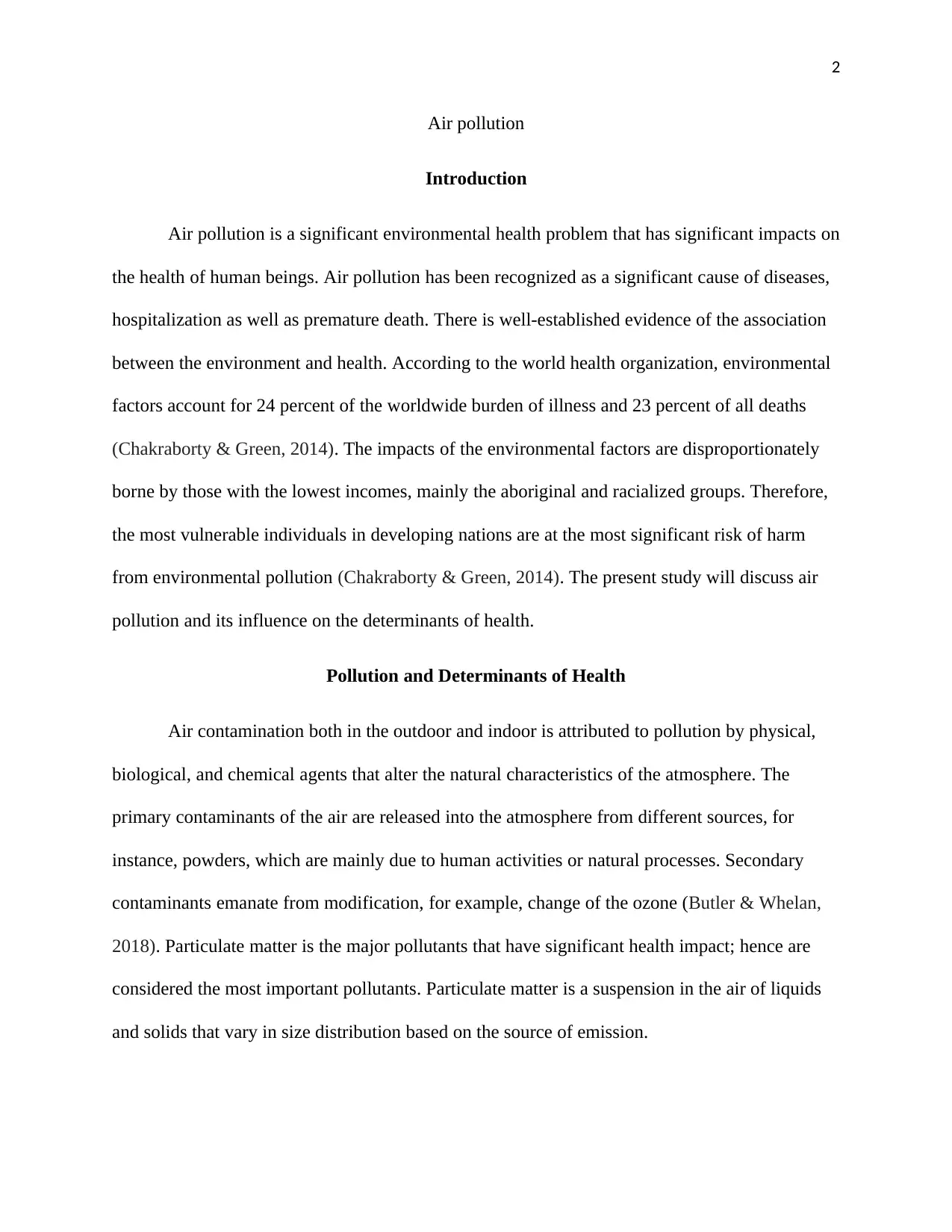
2
Air pollution
Introduction
Air pollution is a significant environmental health problem that has significant impacts on
the health of human beings. Air pollution has been recognized as a significant cause of diseases,
hospitalization as well as premature death. There is well-established evidence of the association
between the environment and health. According to the world health organization, environmental
factors account for 24 percent of the worldwide burden of illness and 23 percent of all deaths
(Chakraborty & Green, 2014). The impacts of the environmental factors are disproportionately
borne by those with the lowest incomes, mainly the aboriginal and racialized groups. Therefore,
the most vulnerable individuals in developing nations are at the most significant risk of harm
from environmental pollution (Chakraborty & Green, 2014). The present study will discuss air
pollution and its influence on the determinants of health.
Pollution and Determinants of Health
Air contamination both in the outdoor and indoor is attributed to pollution by physical,
biological, and chemical agents that alter the natural characteristics of the atmosphere. The
primary contaminants of the air are released into the atmosphere from different sources, for
instance, powders, which are mainly due to human activities or natural processes. Secondary
contaminants emanate from modification, for example, change of the ozone (Butler & Whelan,
2018). Particulate matter is the major pollutants that have significant health impact; hence are
considered the most important pollutants. Particulate matter is a suspension in the air of liquids
and solids that vary in size distribution based on the source of emission.
Air pollution
Introduction
Air pollution is a significant environmental health problem that has significant impacts on
the health of human beings. Air pollution has been recognized as a significant cause of diseases,
hospitalization as well as premature death. There is well-established evidence of the association
between the environment and health. According to the world health organization, environmental
factors account for 24 percent of the worldwide burden of illness and 23 percent of all deaths
(Chakraborty & Green, 2014). The impacts of the environmental factors are disproportionately
borne by those with the lowest incomes, mainly the aboriginal and racialized groups. Therefore,
the most vulnerable individuals in developing nations are at the most significant risk of harm
from environmental pollution (Chakraborty & Green, 2014). The present study will discuss air
pollution and its influence on the determinants of health.
Pollution and Determinants of Health
Air contamination both in the outdoor and indoor is attributed to pollution by physical,
biological, and chemical agents that alter the natural characteristics of the atmosphere. The
primary contaminants of the air are released into the atmosphere from different sources, for
instance, powders, which are mainly due to human activities or natural processes. Secondary
contaminants emanate from modification, for example, change of the ozone (Butler & Whelan,
2018). Particulate matter is the major pollutants that have significant health impact; hence are
considered the most important pollutants. Particulate matter is a suspension in the air of liquids
and solids that vary in size distribution based on the source of emission.
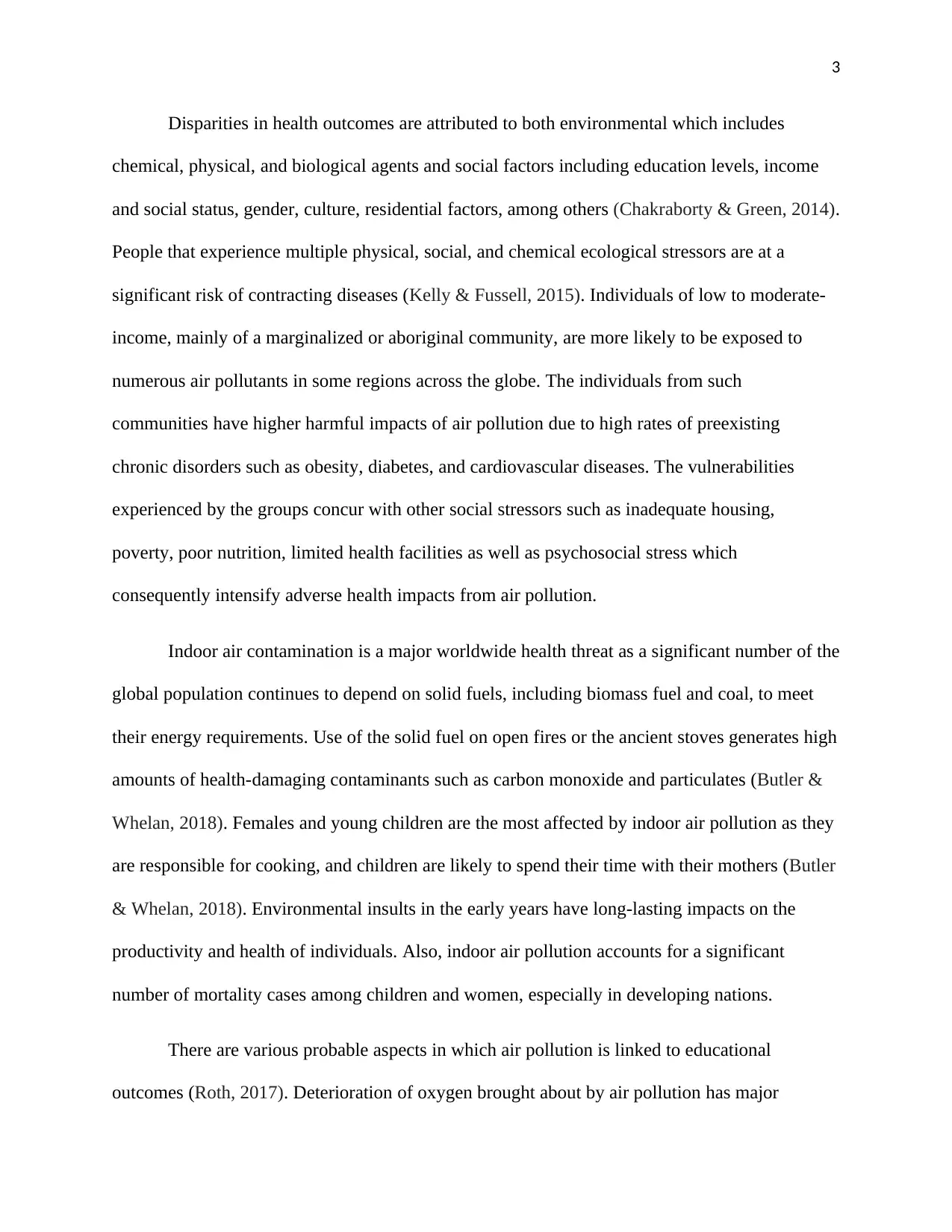
3
Disparities in health outcomes are attributed to both environmental which includes
chemical, physical, and biological agents and social factors including education levels, income
and social status, gender, culture, residential factors, among others (Chakraborty & Green, 2014).
People that experience multiple physical, social, and chemical ecological stressors are at a
significant risk of contracting diseases (Kelly & Fussell, 2015). Individuals of low to moderate-
income, mainly of a marginalized or aboriginal community, are more likely to be exposed to
numerous air pollutants in some regions across the globe. The individuals from such
communities have higher harmful impacts of air pollution due to high rates of preexisting
chronic disorders such as obesity, diabetes, and cardiovascular diseases. The vulnerabilities
experienced by the groups concur with other social stressors such as inadequate housing,
poverty, poor nutrition, limited health facilities as well as psychosocial stress which
consequently intensify adverse health impacts from air pollution.
Indoor air contamination is a major worldwide health threat as a significant number of the
global population continues to depend on solid fuels, including biomass fuel and coal, to meet
their energy requirements. Use of the solid fuel on open fires or the ancient stoves generates high
amounts of health-damaging contaminants such as carbon monoxide and particulates (Butler &
Whelan, 2018). Females and young children are the most affected by indoor air pollution as they
are responsible for cooking, and children are likely to spend their time with their mothers (Butler
& Whelan, 2018). Environmental insults in the early years have long-lasting impacts on the
productivity and health of individuals. Also, indoor air pollution accounts for a significant
number of mortality cases among children and women, especially in developing nations.
There are various probable aspects in which air pollution is linked to educational
outcomes (Roth, 2017). Deterioration of oxygen brought about by air pollution has major
Disparities in health outcomes are attributed to both environmental which includes
chemical, physical, and biological agents and social factors including education levels, income
and social status, gender, culture, residential factors, among others (Chakraborty & Green, 2014).
People that experience multiple physical, social, and chemical ecological stressors are at a
significant risk of contracting diseases (Kelly & Fussell, 2015). Individuals of low to moderate-
income, mainly of a marginalized or aboriginal community, are more likely to be exposed to
numerous air pollutants in some regions across the globe. The individuals from such
communities have higher harmful impacts of air pollution due to high rates of preexisting
chronic disorders such as obesity, diabetes, and cardiovascular diseases. The vulnerabilities
experienced by the groups concur with other social stressors such as inadequate housing,
poverty, poor nutrition, limited health facilities as well as psychosocial stress which
consequently intensify adverse health impacts from air pollution.
Indoor air contamination is a major worldwide health threat as a significant number of the
global population continues to depend on solid fuels, including biomass fuel and coal, to meet
their energy requirements. Use of the solid fuel on open fires or the ancient stoves generates high
amounts of health-damaging contaminants such as carbon monoxide and particulates (Butler &
Whelan, 2018). Females and young children are the most affected by indoor air pollution as they
are responsible for cooking, and children are likely to spend their time with their mothers (Butler
& Whelan, 2018). Environmental insults in the early years have long-lasting impacts on the
productivity and health of individuals. Also, indoor air pollution accounts for a significant
number of mortality cases among children and women, especially in developing nations.
There are various probable aspects in which air pollution is linked to educational
outcomes (Roth, 2017). Deterioration of oxygen brought about by air pollution has major
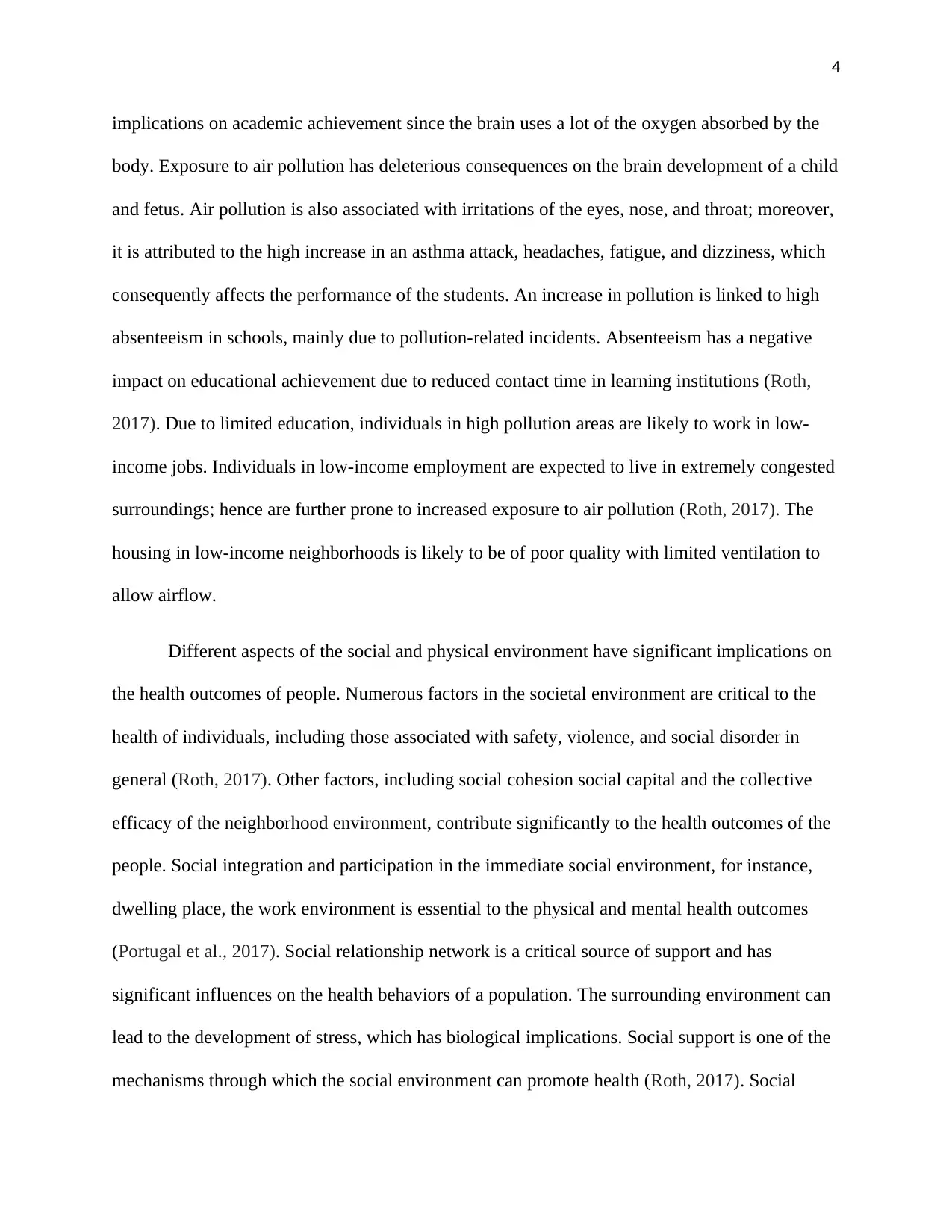
4
implications on academic achievement since the brain uses a lot of the oxygen absorbed by the
body. Exposure to air pollution has deleterious consequences on the brain development of a child
and fetus. Air pollution is also associated with irritations of the eyes, nose, and throat; moreover,
it is attributed to the high increase in an asthma attack, headaches, fatigue, and dizziness, which
consequently affects the performance of the students. An increase in pollution is linked to high
absenteeism in schools, mainly due to pollution-related incidents. Absenteeism has a negative
impact on educational achievement due to reduced contact time in learning institutions (Roth,
2017). Due to limited education, individuals in high pollution areas are likely to work in low-
income jobs. Individuals in low-income employment are expected to live in extremely congested
surroundings; hence are further prone to increased exposure to air pollution (Roth, 2017). The
housing in low-income neighborhoods is likely to be of poor quality with limited ventilation to
allow airflow.
Different aspects of the social and physical environment have significant implications on
the health outcomes of people. Numerous factors in the societal environment are critical to the
health of individuals, including those associated with safety, violence, and social disorder in
general (Roth, 2017). Other factors, including social cohesion social capital and the collective
efficacy of the neighborhood environment, contribute significantly to the health outcomes of the
people. Social integration and participation in the immediate social environment, for instance,
dwelling place, the work environment is essential to the physical and mental health outcomes
(Portugal et al., 2017). Social relationship network is a critical source of support and has
significant influences on the health behaviors of a population. The surrounding environment can
lead to the development of stress, which has biological implications. Social support is one of the
mechanisms through which the social environment can promote health (Roth, 2017). Social
implications on academic achievement since the brain uses a lot of the oxygen absorbed by the
body. Exposure to air pollution has deleterious consequences on the brain development of a child
and fetus. Air pollution is also associated with irritations of the eyes, nose, and throat; moreover,
it is attributed to the high increase in an asthma attack, headaches, fatigue, and dizziness, which
consequently affects the performance of the students. An increase in pollution is linked to high
absenteeism in schools, mainly due to pollution-related incidents. Absenteeism has a negative
impact on educational achievement due to reduced contact time in learning institutions (Roth,
2017). Due to limited education, individuals in high pollution areas are likely to work in low-
income jobs. Individuals in low-income employment are expected to live in extremely congested
surroundings; hence are further prone to increased exposure to air pollution (Roth, 2017). The
housing in low-income neighborhoods is likely to be of poor quality with limited ventilation to
allow airflow.
Different aspects of the social and physical environment have significant implications on
the health outcomes of people. Numerous factors in the societal environment are critical to the
health of individuals, including those associated with safety, violence, and social disorder in
general (Roth, 2017). Other factors, including social cohesion social capital and the collective
efficacy of the neighborhood environment, contribute significantly to the health outcomes of the
people. Social integration and participation in the immediate social environment, for instance,
dwelling place, the work environment is essential to the physical and mental health outcomes
(Portugal et al., 2017). Social relationship network is a critical source of support and has
significant influences on the health behaviors of a population. The surrounding environment can
lead to the development of stress, which has biological implications. Social support is one of the
mechanisms through which the social environment can promote health (Roth, 2017). Social
Paraphrase This Document
Need a fresh take? Get an instant paraphrase of this document with our AI Paraphraser
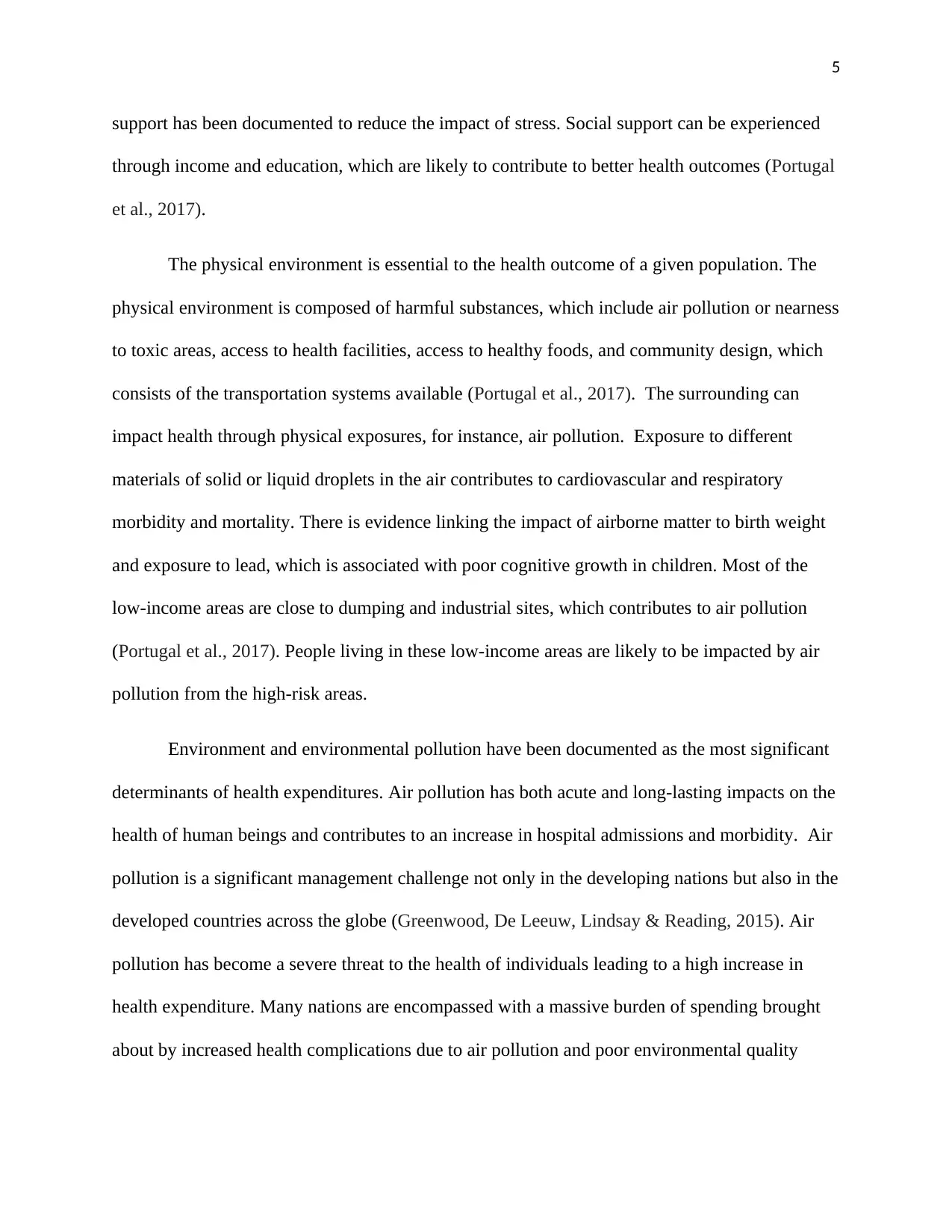
5
support has been documented to reduce the impact of stress. Social support can be experienced
through income and education, which are likely to contribute to better health outcomes (Portugal
et al., 2017).
The physical environment is essential to the health outcome of a given population. The
physical environment is composed of harmful substances, which include air pollution or nearness
to toxic areas, access to health facilities, access to healthy foods, and community design, which
consists of the transportation systems available (Portugal et al., 2017). The surrounding can
impact health through physical exposures, for instance, air pollution. Exposure to different
materials of solid or liquid droplets in the air contributes to cardiovascular and respiratory
morbidity and mortality. There is evidence linking the impact of airborne matter to birth weight
and exposure to lead, which is associated with poor cognitive growth in children. Most of the
low-income areas are close to dumping and industrial sites, which contributes to air pollution
(Portugal et al., 2017). People living in these low-income areas are likely to be impacted by air
pollution from the high-risk areas.
Environment and environmental pollution have been documented as the most significant
determinants of health expenditures. Air pollution has both acute and long-lasting impacts on the
health of human beings and contributes to an increase in hospital admissions and morbidity. Air
pollution is a significant management challenge not only in the developing nations but also in the
developed countries across the globe (Greenwood, De Leeuw, Lindsay & Reading, 2015). Air
pollution has become a severe threat to the health of individuals leading to a high increase in
health expenditure. Many nations are encompassed with a massive burden of spending brought
about by increased health complications due to air pollution and poor environmental quality
support has been documented to reduce the impact of stress. Social support can be experienced
through income and education, which are likely to contribute to better health outcomes (Portugal
et al., 2017).
The physical environment is essential to the health outcome of a given population. The
physical environment is composed of harmful substances, which include air pollution or nearness
to toxic areas, access to health facilities, access to healthy foods, and community design, which
consists of the transportation systems available (Portugal et al., 2017). The surrounding can
impact health through physical exposures, for instance, air pollution. Exposure to different
materials of solid or liquid droplets in the air contributes to cardiovascular and respiratory
morbidity and mortality. There is evidence linking the impact of airborne matter to birth weight
and exposure to lead, which is associated with poor cognitive growth in children. Most of the
low-income areas are close to dumping and industrial sites, which contributes to air pollution
(Portugal et al., 2017). People living in these low-income areas are likely to be impacted by air
pollution from the high-risk areas.
Environment and environmental pollution have been documented as the most significant
determinants of health expenditures. Air pollution has both acute and long-lasting impacts on the
health of human beings and contributes to an increase in hospital admissions and morbidity. Air
pollution is a significant management challenge not only in the developing nations but also in the
developed countries across the globe (Greenwood, De Leeuw, Lindsay & Reading, 2015). Air
pollution has become a severe threat to the health of individuals leading to a high increase in
health expenditure. Many nations are encompassed with a massive burden of spending brought
about by increased health complications due to air pollution and poor environmental quality

6
(Greenwood et al., 2015). Therefore, the health burden brought about by air pollution leads to
significant economic consequences.
Environmental exposures, together with genetic variations, influence disease
susceptibility. People have different genetic mutations and hence are likely to respond
differently to environmental variation, and exhibit an array of the phenotypic landscape. Genetic
and environment interactions are responsible for a significant number of variations in heritability
and the risk of developing different diseases (Marmot & Allen, 2014). Genetic susceptibility
plays a vital role in response to air pollution exposure. Different genes are involved in the
diverse air pollutant response phenotypes; hence, some individuals are likely to have significant
implications from pollution, while others may not be affected (Marmot & Allen, 2014).
Environmental impacts have different implications on men and women due to gender
inequalities. Women represent a significant number of the poor in the society with their
economic insecurity being part of a chain of disadvantages often brought about by discrimination
in land ownership and employment in addition to limited access to essential resources (Koman et
al., 2018). In many communities,' women are tasked with the responsibilities in the household
hence are likely to be disproportionately exposed to indoor air pollution. Women are likely to be
paid less than men for the same work, and in most instances, they are often expected to work in
the informal sector where they are exposed to different life-threatening factors, including air
pollution (Koman et al., 2018). Therefore, women are more likely than men to be impacted by air
pollution.
Income and social status and implication on health
(Greenwood et al., 2015). Therefore, the health burden brought about by air pollution leads to
significant economic consequences.
Environmental exposures, together with genetic variations, influence disease
susceptibility. People have different genetic mutations and hence are likely to respond
differently to environmental variation, and exhibit an array of the phenotypic landscape. Genetic
and environment interactions are responsible for a significant number of variations in heritability
and the risk of developing different diseases (Marmot & Allen, 2014). Genetic susceptibility
plays a vital role in response to air pollution exposure. Different genes are involved in the
diverse air pollutant response phenotypes; hence, some individuals are likely to have significant
implications from pollution, while others may not be affected (Marmot & Allen, 2014).
Environmental impacts have different implications on men and women due to gender
inequalities. Women represent a significant number of the poor in the society with their
economic insecurity being part of a chain of disadvantages often brought about by discrimination
in land ownership and employment in addition to limited access to essential resources (Koman et
al., 2018). In many communities,' women are tasked with the responsibilities in the household
hence are likely to be disproportionately exposed to indoor air pollution. Women are likely to be
paid less than men for the same work, and in most instances, they are often expected to work in
the informal sector where they are exposed to different life-threatening factors, including air
pollution (Koman et al., 2018). Therefore, women are more likely than men to be impacted by air
pollution.
Income and social status and implication on health
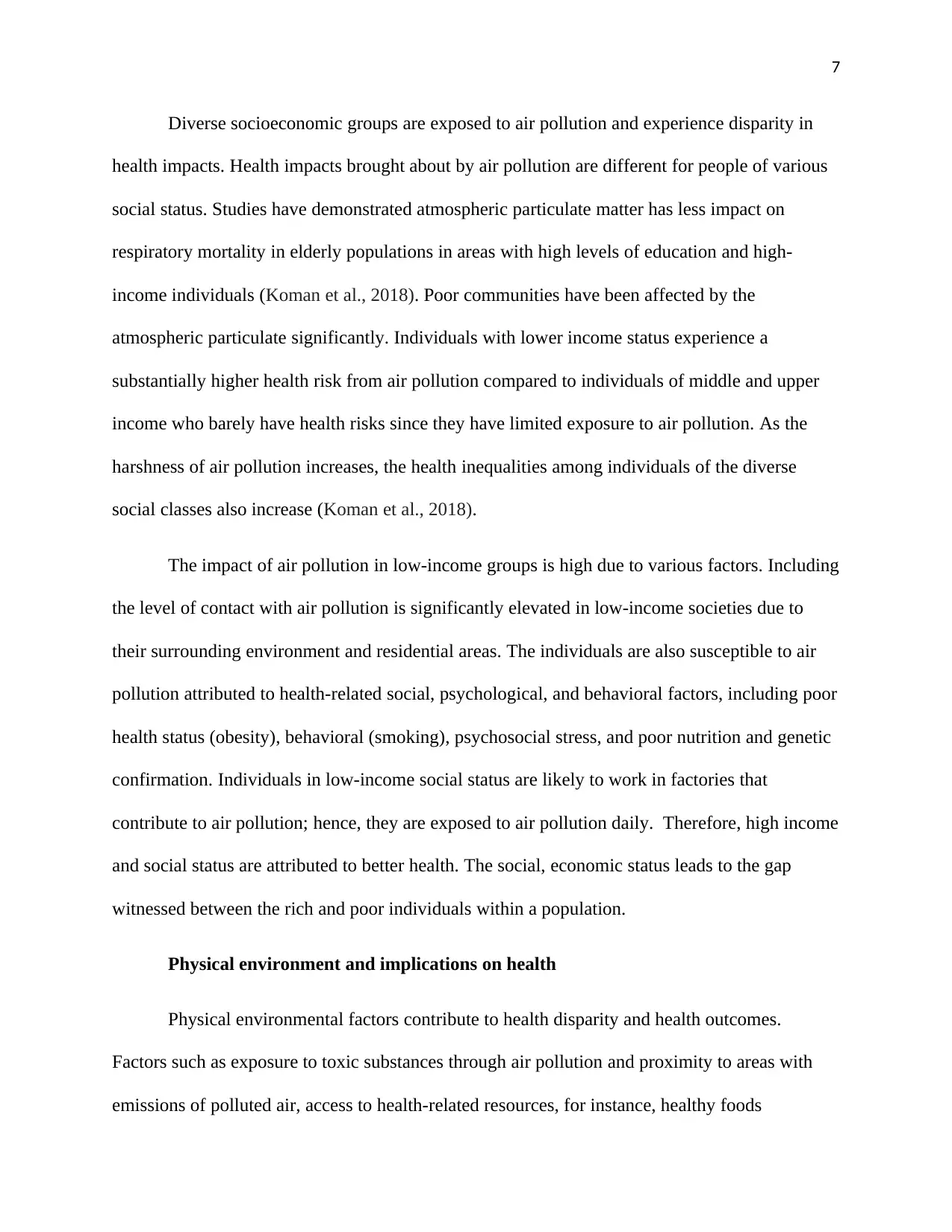
7
Diverse socioeconomic groups are exposed to air pollution and experience disparity in
health impacts. Health impacts brought about by air pollution are different for people of various
social status. Studies have demonstrated atmospheric particulate matter has less impact on
respiratory mortality in elderly populations in areas with high levels of education and high-
income individuals (Koman et al., 2018). Poor communities have been affected by the
atmospheric particulate significantly. Individuals with lower income status experience a
substantially higher health risk from air pollution compared to individuals of middle and upper
income who barely have health risks since they have limited exposure to air pollution. As the
harshness of air pollution increases, the health inequalities among individuals of the diverse
social classes also increase (Koman et al., 2018).
The impact of air pollution in low-income groups is high due to various factors. Including
the level of contact with air pollution is significantly elevated in low-income societies due to
their surrounding environment and residential areas. The individuals are also susceptible to air
pollution attributed to health-related social, psychological, and behavioral factors, including poor
health status (obesity), behavioral (smoking), psychosocial stress, and poor nutrition and genetic
confirmation. Individuals in low-income social status are likely to work in factories that
contribute to air pollution; hence, they are exposed to air pollution daily. Therefore, high income
and social status are attributed to better health. The social, economic status leads to the gap
witnessed between the rich and poor individuals within a population.
Physical environment and implications on health
Physical environmental factors contribute to health disparity and health outcomes.
Factors such as exposure to toxic substances through air pollution and proximity to areas with
emissions of polluted air, access to health-related resources, for instance, healthy foods
Diverse socioeconomic groups are exposed to air pollution and experience disparity in
health impacts. Health impacts brought about by air pollution are different for people of various
social status. Studies have demonstrated atmospheric particulate matter has less impact on
respiratory mortality in elderly populations in areas with high levels of education and high-
income individuals (Koman et al., 2018). Poor communities have been affected by the
atmospheric particulate significantly. Individuals with lower income status experience a
substantially higher health risk from air pollution compared to individuals of middle and upper
income who barely have health risks since they have limited exposure to air pollution. As the
harshness of air pollution increases, the health inequalities among individuals of the diverse
social classes also increase (Koman et al., 2018).
The impact of air pollution in low-income groups is high due to various factors. Including
the level of contact with air pollution is significantly elevated in low-income societies due to
their surrounding environment and residential areas. The individuals are also susceptible to air
pollution attributed to health-related social, psychological, and behavioral factors, including poor
health status (obesity), behavioral (smoking), psychosocial stress, and poor nutrition and genetic
confirmation. Individuals in low-income social status are likely to work in factories that
contribute to air pollution; hence, they are exposed to air pollution daily. Therefore, high income
and social status are attributed to better health. The social, economic status leads to the gap
witnessed between the rich and poor individuals within a population.
Physical environment and implications on health
Physical environmental factors contribute to health disparity and health outcomes.
Factors such as exposure to toxic substances through air pollution and proximity to areas with
emissions of polluted air, access to health-related resources, for instance, healthy foods
Secure Best Marks with AI Grader
Need help grading? Try our AI Grader for instant feedback on your assignments.
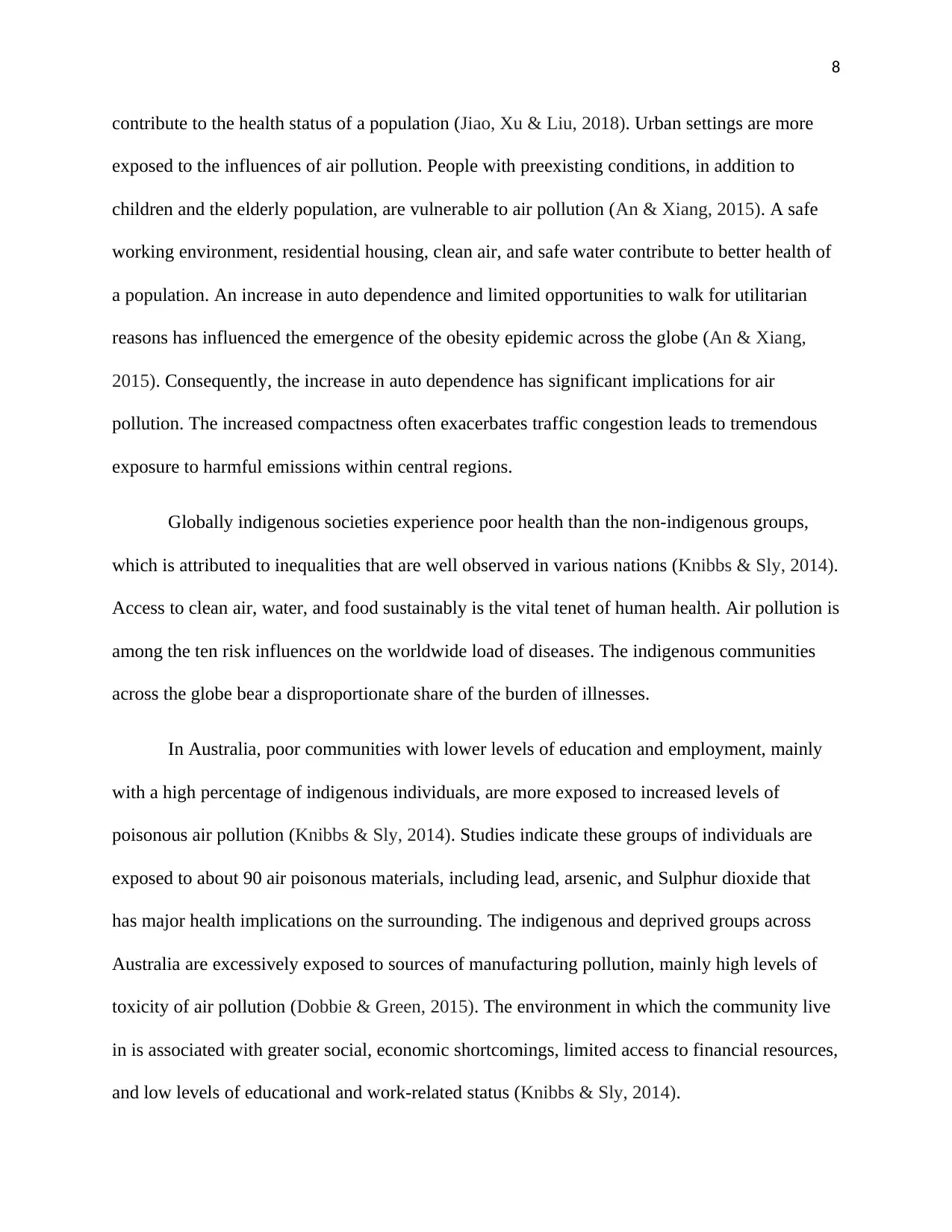
8
contribute to the health status of a population (Jiao, Xu & Liu, 2018). Urban settings are more
exposed to the influences of air pollution. People with preexisting conditions, in addition to
children and the elderly population, are vulnerable to air pollution (An & Xiang, 2015). A safe
working environment, residential housing, clean air, and safe water contribute to better health of
a population. An increase in auto dependence and limited opportunities to walk for utilitarian
reasons has influenced the emergence of the obesity epidemic across the globe (An & Xiang,
2015). Consequently, the increase in auto dependence has significant implications for air
pollution. The increased compactness often exacerbates traffic congestion leads to tremendous
exposure to harmful emissions within central regions.
Globally indigenous societies experience poor health than the non-indigenous groups,
which is attributed to inequalities that are well observed in various nations (Knibbs & Sly, 2014).
Access to clean air, water, and food sustainably is the vital tenet of human health. Air pollution is
among the ten risk influences on the worldwide load of diseases. The indigenous communities
across the globe bear a disproportionate share of the burden of illnesses.
In Australia, poor communities with lower levels of education and employment, mainly
with a high percentage of indigenous individuals, are more exposed to increased levels of
poisonous air pollution (Knibbs & Sly, 2014). Studies indicate these groups of individuals are
exposed to about 90 air poisonous materials, including lead, arsenic, and Sulphur dioxide that
has major health implications on the surrounding. The indigenous and deprived groups across
Australia are excessively exposed to sources of manufacturing pollution, mainly high levels of
toxicity of air pollution (Dobbie & Green, 2015). The environment in which the community live
in is associated with greater social, economic shortcomings, limited access to financial resources,
and low levels of educational and work-related status (Knibbs & Sly, 2014).
contribute to the health status of a population (Jiao, Xu & Liu, 2018). Urban settings are more
exposed to the influences of air pollution. People with preexisting conditions, in addition to
children and the elderly population, are vulnerable to air pollution (An & Xiang, 2015). A safe
working environment, residential housing, clean air, and safe water contribute to better health of
a population. An increase in auto dependence and limited opportunities to walk for utilitarian
reasons has influenced the emergence of the obesity epidemic across the globe (An & Xiang,
2015). Consequently, the increase in auto dependence has significant implications for air
pollution. The increased compactness often exacerbates traffic congestion leads to tremendous
exposure to harmful emissions within central regions.
Globally indigenous societies experience poor health than the non-indigenous groups,
which is attributed to inequalities that are well observed in various nations (Knibbs & Sly, 2014).
Access to clean air, water, and food sustainably is the vital tenet of human health. Air pollution is
among the ten risk influences on the worldwide load of diseases. The indigenous communities
across the globe bear a disproportionate share of the burden of illnesses.
In Australia, poor communities with lower levels of education and employment, mainly
with a high percentage of indigenous individuals, are more exposed to increased levels of
poisonous air pollution (Knibbs & Sly, 2014). Studies indicate these groups of individuals are
exposed to about 90 air poisonous materials, including lead, arsenic, and Sulphur dioxide that
has major health implications on the surrounding. The indigenous and deprived groups across
Australia are excessively exposed to sources of manufacturing pollution, mainly high levels of
toxicity of air pollution (Dobbie & Green, 2015). The environment in which the community live
in is associated with greater social, economic shortcomings, limited access to financial resources,
and low levels of educational and work-related status (Knibbs & Sly, 2014).

9
Graph Indicating Rate of Respiratory Symptoms Presentation in Australia
Some parts of South Australia, for instance, port Pirie is an example of a community that
is exposed to toxic air. The residents of the town are exposed to harmful emissions. Port Pirie is
one of the lowest social, economic regions in South Australia. Port Pirie has been affected by
lead smelting emissions for more than 125 years (Dobbie & Green, 2015). The main cause of
lead poisoning in this region is fine to lead dust that is easily blown by the wind into the
neighboring households (Taylor, Isley & Glover, 2019). The air in the region is contaminated
with lead and zinc-based dust, which is emitted during smelting operations where the particles
are transported by wind and deposited in the city and houses neighboring the area (Taylor et al.,
Graph Indicating Rate of Respiratory Symptoms Presentation in Australia
Some parts of South Australia, for instance, port Pirie is an example of a community that
is exposed to toxic air. The residents of the town are exposed to harmful emissions. Port Pirie is
one of the lowest social, economic regions in South Australia. Port Pirie has been affected by
lead smelting emissions for more than 125 years (Dobbie & Green, 2015). The main cause of
lead poisoning in this region is fine to lead dust that is easily blown by the wind into the
neighboring households (Taylor, Isley & Glover, 2019). The air in the region is contaminated
with lead and zinc-based dust, which is emitted during smelting operations where the particles
are transported by wind and deposited in the city and houses neighboring the area (Taylor et al.,
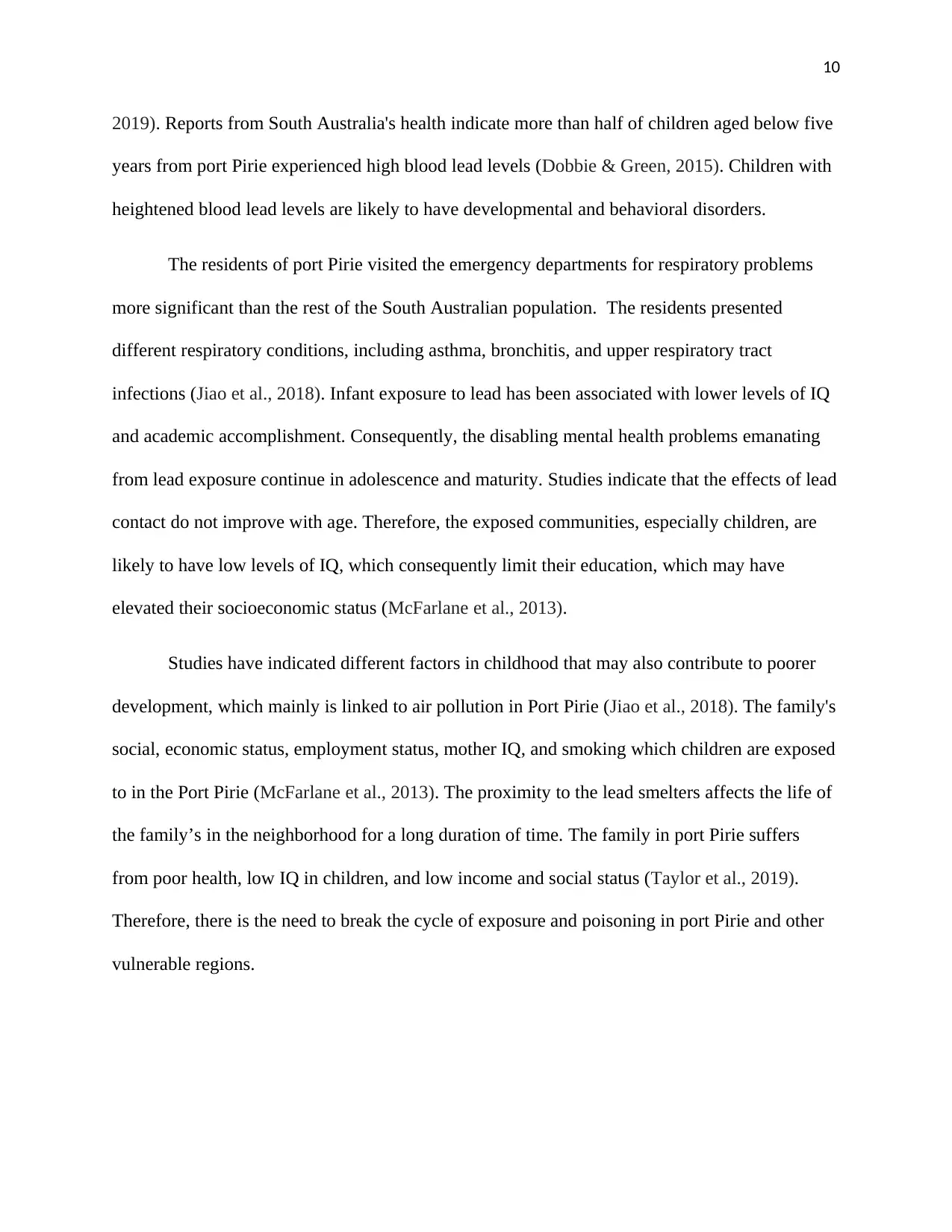
10
2019). Reports from South Australia's health indicate more than half of children aged below five
years from port Pirie experienced high blood lead levels (Dobbie & Green, 2015). Children with
heightened blood lead levels are likely to have developmental and behavioral disorders.
The residents of port Pirie visited the emergency departments for respiratory problems
more significant than the rest of the South Australian population. The residents presented
different respiratory conditions, including asthma, bronchitis, and upper respiratory tract
infections (Jiao et al., 2018). Infant exposure to lead has been associated with lower levels of IQ
and academic accomplishment. Consequently, the disabling mental health problems emanating
from lead exposure continue in adolescence and maturity. Studies indicate that the effects of lead
contact do not improve with age. Therefore, the exposed communities, especially children, are
likely to have low levels of IQ, which consequently limit their education, which may have
elevated their socioeconomic status (McFarlane et al., 2013).
Studies have indicated different factors in childhood that may also contribute to poorer
development, which mainly is linked to air pollution in Port Pirie (Jiao et al., 2018). The family's
social, economic status, employment status, mother IQ, and smoking which children are exposed
to in the Port Pirie (McFarlane et al., 2013). The proximity to the lead smelters affects the life of
the family’s in the neighborhood for a long duration of time. The family in port Pirie suffers
from poor health, low IQ in children, and low income and social status (Taylor et al., 2019).
Therefore, there is the need to break the cycle of exposure and poisoning in port Pirie and other
vulnerable regions.
2019). Reports from South Australia's health indicate more than half of children aged below five
years from port Pirie experienced high blood lead levels (Dobbie & Green, 2015). Children with
heightened blood lead levels are likely to have developmental and behavioral disorders.
The residents of port Pirie visited the emergency departments for respiratory problems
more significant than the rest of the South Australian population. The residents presented
different respiratory conditions, including asthma, bronchitis, and upper respiratory tract
infections (Jiao et al., 2018). Infant exposure to lead has been associated with lower levels of IQ
and academic accomplishment. Consequently, the disabling mental health problems emanating
from lead exposure continue in adolescence and maturity. Studies indicate that the effects of lead
contact do not improve with age. Therefore, the exposed communities, especially children, are
likely to have low levels of IQ, which consequently limit their education, which may have
elevated their socioeconomic status (McFarlane et al., 2013).
Studies have indicated different factors in childhood that may also contribute to poorer
development, which mainly is linked to air pollution in Port Pirie (Jiao et al., 2018). The family's
social, economic status, employment status, mother IQ, and smoking which children are exposed
to in the Port Pirie (McFarlane et al., 2013). The proximity to the lead smelters affects the life of
the family’s in the neighborhood for a long duration of time. The family in port Pirie suffers
from poor health, low IQ in children, and low income and social status (Taylor et al., 2019).
Therefore, there is the need to break the cycle of exposure and poisoning in port Pirie and other
vulnerable regions.
Paraphrase This Document
Need a fresh take? Get an instant paraphrase of this document with our AI Paraphraser

11
Conclusion
To conclude, there is clear evidence that environmental factors, air pollution, has major
implications on the health disadvantage and worse and more inequitably distributed in low-
income communities. The study indicates the link between the determinants of health and
environmental issues. Air pollution is linked to poor health outcomes in marginalized and
aboriginal communities due to their proximity to processing and dumping sites. The
communities near air pollution prone regions have low social and income status. Air pollution
has major implications on the IQ and educational achievement of individuals under exposure to a
high level of toxic pollutants. The study has indicated there is a major link between the exposure
to polluted air and level of intelligence, where the children from the polluted air environment
recorded low levels of IQ. Individuals living in Port Pirie have been identified as a vulnerable
community to air pollution due to the evident exposure to lead. Exposure to lead is a major
public hazard, and hence measure needs to be put in place to prevent any exposure to harmful
levels of lead, especially to children. In addition, to deal with environmental health factors and
health outcomes concerning the environmental effects, the government and concerned
organizations need to consider the different determinants of health, which play a significant role
in influencing the health outcome of individuals.
Conclusion
To conclude, there is clear evidence that environmental factors, air pollution, has major
implications on the health disadvantage and worse and more inequitably distributed in low-
income communities. The study indicates the link between the determinants of health and
environmental issues. Air pollution is linked to poor health outcomes in marginalized and
aboriginal communities due to their proximity to processing and dumping sites. The
communities near air pollution prone regions have low social and income status. Air pollution
has major implications on the IQ and educational achievement of individuals under exposure to a
high level of toxic pollutants. The study has indicated there is a major link between the exposure
to polluted air and level of intelligence, where the children from the polluted air environment
recorded low levels of IQ. Individuals living in Port Pirie have been identified as a vulnerable
community to air pollution due to the evident exposure to lead. Exposure to lead is a major
public hazard, and hence measure needs to be put in place to prevent any exposure to harmful
levels of lead, especially to children. In addition, to deal with environmental health factors and
health outcomes concerning the environmental effects, the government and concerned
organizations need to consider the different determinants of health, which play a significant role
in influencing the health outcome of individuals.
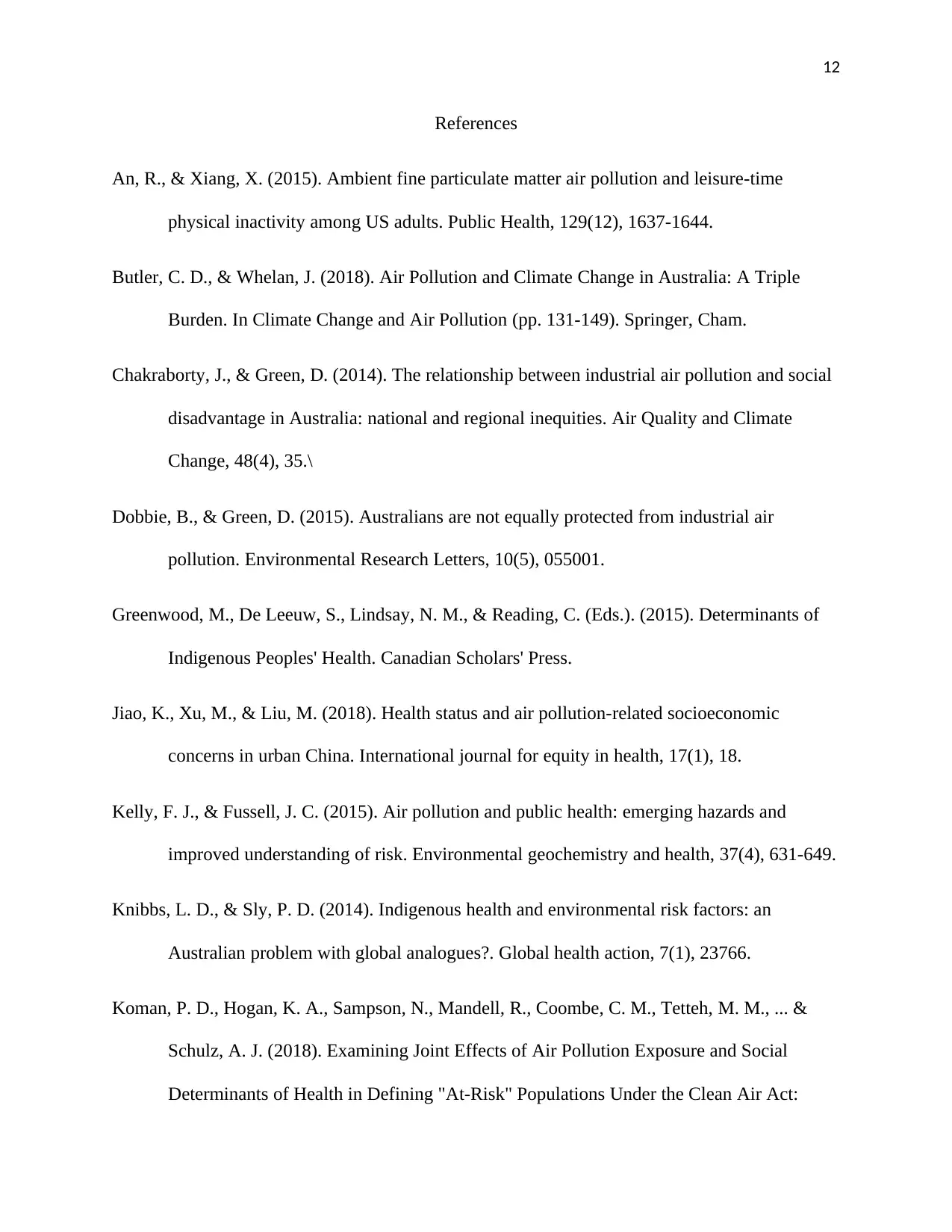
12
References
An, R., & Xiang, X. (2015). Ambient fine particulate matter air pollution and leisure-time
physical inactivity among US adults. Public Health, 129(12), 1637-1644.
Butler, C. D., & Whelan, J. (2018). Air Pollution and Climate Change in Australia: A Triple
Burden. In Climate Change and Air Pollution (pp. 131-149). Springer, Cham.
Chakraborty, J., & Green, D. (2014). The relationship between industrial air pollution and social
disadvantage in Australia: national and regional inequities. Air Quality and Climate
Change, 48(4), 35.\
Dobbie, B., & Green, D. (2015). Australians are not equally protected from industrial air
pollution. Environmental Research Letters, 10(5), 055001.
Greenwood, M., De Leeuw, S., Lindsay, N. M., & Reading, C. (Eds.). (2015). Determinants of
Indigenous Peoples' Health. Canadian Scholars' Press.
Jiao, K., Xu, M., & Liu, M. (2018). Health status and air pollution-related socioeconomic
concerns in urban China. International journal for equity in health, 17(1), 18.
Kelly, F. J., & Fussell, J. C. (2015). Air pollution and public health: emerging hazards and
improved understanding of risk. Environmental geochemistry and health, 37(4), 631-649.
Knibbs, L. D., & Sly, P. D. (2014). Indigenous health and environmental risk factors: an
Australian problem with global analogues?. Global health action, 7(1), 23766.
Koman, P. D., Hogan, K. A., Sampson, N., Mandell, R., Coombe, C. M., Tetteh, M. M., ... &
Schulz, A. J. (2018). Examining Joint Effects of Air Pollution Exposure and Social
Determinants of Health in Defining "At‐Risk" Populations Under the Clean Air Act:
References
An, R., & Xiang, X. (2015). Ambient fine particulate matter air pollution and leisure-time
physical inactivity among US adults. Public Health, 129(12), 1637-1644.
Butler, C. D., & Whelan, J. (2018). Air Pollution and Climate Change in Australia: A Triple
Burden. In Climate Change and Air Pollution (pp. 131-149). Springer, Cham.
Chakraborty, J., & Green, D. (2014). The relationship between industrial air pollution and social
disadvantage in Australia: national and regional inequities. Air Quality and Climate
Change, 48(4), 35.\
Dobbie, B., & Green, D. (2015). Australians are not equally protected from industrial air
pollution. Environmental Research Letters, 10(5), 055001.
Greenwood, M., De Leeuw, S., Lindsay, N. M., & Reading, C. (Eds.). (2015). Determinants of
Indigenous Peoples' Health. Canadian Scholars' Press.
Jiao, K., Xu, M., & Liu, M. (2018). Health status and air pollution-related socioeconomic
concerns in urban China. International journal for equity in health, 17(1), 18.
Kelly, F. J., & Fussell, J. C. (2015). Air pollution and public health: emerging hazards and
improved understanding of risk. Environmental geochemistry and health, 37(4), 631-649.
Knibbs, L. D., & Sly, P. D. (2014). Indigenous health and environmental risk factors: an
Australian problem with global analogues?. Global health action, 7(1), 23766.
Koman, P. D., Hogan, K. A., Sampson, N., Mandell, R., Coombe, C. M., Tetteh, M. M., ... &
Schulz, A. J. (2018). Examining Joint Effects of Air Pollution Exposure and Social
Determinants of Health in Defining "At‐Risk" Populations Under the Clean Air Act:

13
Susceptibility of Pregnant Women to Hypertensive Disorders of Pregnancy. World
Medical & health policy, 10(1), 7-54.
Marmot, M., & Allen, J. J. (2014). Social determinants of health equity.
McFarlane, A. C., Searle, A. K., Van Hooff, M., Baghurst, P. A., Sawyer, M. G., Galletly, C., ...
& Clark, L. S. (2013). Prospective associations between childhood low-level lead
exposure and adult mental health problems: The Port Pirie cohort study.
Neurotoxicology, 39, 11-17.
Portugal, F. B., Campos, M. R., Correia, C. R., Gonçalves, D. A., Ballester, D., Tófoli, L. F., ...
& Fortes, S. (2016). Social support network, mental health, and quality of life: a cross-
sectional study in primary care. Cadernos de Saude public, 32, e00165115.
Purdom, P. W. (Ed.). (2013). Environmental health. Elsevier.
Roth, S. (2017). Air pollution, educational achievements, and human capital formation. IZA
World of Labor.
Sass, V., Kravitz-Wirtz, N., Karceski, S. M., Hajat, A., Crowder, K., & Takeuchi, D. (2017). The
effects of air pollution on individual psychological distress. Health & place, 48, 72-79.
Taylor, M. P., Isley, C. F., & Glover, J. (2019). Prevalence of childhood lead poisoning and
respiratory disease associated with lead smelter emissions. Environment international,
127, 340-352.
Susceptibility of Pregnant Women to Hypertensive Disorders of Pregnancy. World
Medical & health policy, 10(1), 7-54.
Marmot, M., & Allen, J. J. (2014). Social determinants of health equity.
McFarlane, A. C., Searle, A. K., Van Hooff, M., Baghurst, P. A., Sawyer, M. G., Galletly, C., ...
& Clark, L. S. (2013). Prospective associations between childhood low-level lead
exposure and adult mental health problems: The Port Pirie cohort study.
Neurotoxicology, 39, 11-17.
Portugal, F. B., Campos, M. R., Correia, C. R., Gonçalves, D. A., Ballester, D., Tófoli, L. F., ...
& Fortes, S. (2016). Social support network, mental health, and quality of life: a cross-
sectional study in primary care. Cadernos de Saude public, 32, e00165115.
Purdom, P. W. (Ed.). (2013). Environmental health. Elsevier.
Roth, S. (2017). Air pollution, educational achievements, and human capital formation. IZA
World of Labor.
Sass, V., Kravitz-Wirtz, N., Karceski, S. M., Hajat, A., Crowder, K., & Takeuchi, D. (2017). The
effects of air pollution on individual psychological distress. Health & place, 48, 72-79.
Taylor, M. P., Isley, C. F., & Glover, J. (2019). Prevalence of childhood lead poisoning and
respiratory disease associated with lead smelter emissions. Environment international,
127, 340-352.
1 out of 13
![[object Object]](/_next/static/media/star-bottom.7253800d.svg)





